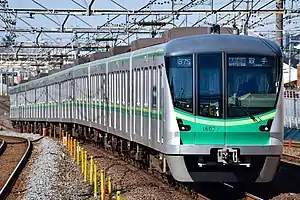Tokyo Metro 7000 series
The Tokyo Metro 7000 series (東京メトロ7000系, Tōkyō Metoro 7000-kei) is an electric multiple unit (EMU) train type operated by the Tokyo subway operator Tokyo Metro in Tokyo, Japan, since 1974. The design is based on the earlier Tokyo Metro 6000 series trains used on the Tokyo Metro Chiyoda Line.
| Tokyo Metro 7000 series | |
|---|---|
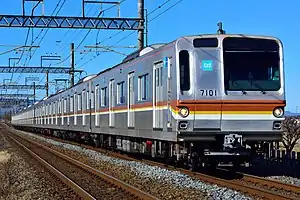 Set 7101 on the Tobu Tojo Line in December 2017 | |
| Manufacturer | Kawasaki Heavy Industries, Kinki Sharyo, Nippon Sharyo and Tokyu Car Corporation |
| Constructed | 1974-1989 |
| Entered service | 1974 |
| Refurbished | 2007 |
| Scrapped | 2007-2009, 2020-2022 (plan) |
| Number built | 340 vehicles (34 10-car sets) |
| Number in service | 180 vehicles (21 sets) (Japan) 24 vehicles (3 sets) (Indonesia) |
| Number scrapped | 120 vehicles (Japan) 8 vehicles (1 set) (Indonesia) |
| Successor | Tokyo Metro 17000 series |
| Formation | 8/10 cars per trainset (Japan) and 8 cars per trainset (Indonesia) |
| Capacity | 136 (48 seating) (end cars), 144 (51/54 seating) (intermediate cars) |
| Operator(s) | Tokyo Metro Kereta Commuter Indonesia |
| Depot(s) | Wakoshi (Japan) and Depok (KCI) |
| Line(s) served | Y Tokyo Metro Yurakucho Line, F Tokyo Metro Fukutoshin Line, TJ Tobu Tojo Line, TY Tokyu Toyoko Line, KRL: Loop Line Red Line (seasonal) Former operations: Green Line (until 2016) Blue Line (end unknown) Tangerang Line (end unknown) (Indonesia) |
| Specifications | |
| Car body construction | Aluminium |
| Car length | 20 m (65 ft 7 in) |
| Width | 2.8 m (9 ft 2 in) |
| Height | 4.145 m (13 ft 7.2 in) |
| Maximum speed | 80 km/h (on Yurakucho Line), 100 km/h (on Tobu Line) |
| Traction system | Chopper control, IGBT-VVVF |
| Power output | 160 kW or 165 kW, previously 150 kW |
| Transmission | Westinghouse-Natal Drive; Gear ratio: 6.53 : 1 |
| Acceleration | 3.3 km/h/s |
| Deceleration | 3.5 km/h/s (4.5 km/h/s for emergency brake) |
| Electric system(s) | 1,500 V DC overhead |
| Bogies | FS-388, FS-388, FS-515 |
| Braking system(s) | Electronically controlled pneumatic brakes with regenerative braking |
| Safety system(s) | New CS-ATC, ATO, ATC-P, T-DATC, Tobu ATS, Seibu ATS |
| Coupling system | Shibata coupler |
| Track gauge | 1,067 mm (3 ft 6 in) |
Operations
7000 series trainsets operate on the following lines.[1]
- ■ Tokyo Metro Yurakucho Line (10-car sets)
- ■ Tokyo Metro Fukutoshin Line (8/10-car sets)
- ■ Tobu Tojo Line between Wakōshi and Shiki (8-car sets) or Shinrinkoen (10-car sets)
- ■ Seibu Yurakucho Line
- ■ Seibu Ikebukuro Line between Kotake-Mukaihara and Hannō
- ■ Tokyu Toyoko Line (since 16 March 2013)
- ■ Minatomirai Line (since 16 March 2013)
Formations
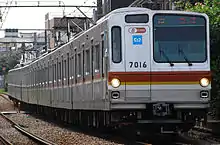
As of 1 April 2017, the fleet consists of six ten-car sets and 15 eight-car sets, formed as shown below with car 1 at the northern end.[1]
10-car sets
| Car No. | 1 | 2 | 3 | 4 | 5 | 6 | 7 | 8 | 9 | 10 |
|---|---|---|---|---|---|---|---|---|---|---|
| Designation | CT2 | M1 | M2 | M1 | Tc2 | Tc1 | M2' | M1 | T2 | CT1 |
| Numbering | 7000 | 7900 | 7800 | 7700 | 7600 | 7500 | 7400 | 7300 | 7200 | 7100 |
only 7102F
| Car No. | 1 | 2 | 3 | 4 | 5 | 6 | 7 | 8 | 9 | 10 |
|---|---|---|---|---|---|---|---|---|---|---|
| Designation | CM2 | M1 | T2 | Tc2 | M2 | M1 | Tc1 | M2' | M1 | CT1 |
| Numbering | 7002 | 7902 | 7202 | 7602 | 7802 | 7702 | 7502 | 7402 | 7302 | 7102 |
- Cars 2, 4, and 8 are each fitted with two lozenge-type pantographs.[1]
- Car 9 is designated as a moderately air-conditioned car.[1]
Interior
Passenger accommodation consists of longitudinal bench seating throughout. Cars 2 and 9 in the ten-car sets and cars 2 and 7 in the eight-car sets each have a wheelchair space.[1] Priority seating is provided at the end of each car.[1]
 Interior of set 7105 which has received type B refurbishment
Interior of set 7105 which has received type B refurbishment Interior of set 7126
Interior of set 7126
History
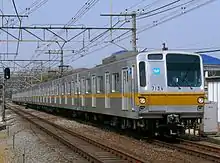
The sets originally sported a yellow bodyside line when used on Yurakucho Line services, but were gradually reliveried with brown, gold, and white stripes coinciding with use on Fukutoshin Line services. The remaining 7000 series sets will be replaced by the 17000 series.
Overseas operations
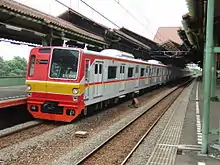
Four 7000 series ten-car sets (7117, 7121, 7122, and 7123) were shipped to Indonesia in 2010 for use on suburban services operated by Kereta Commuter Indonesia (previously called "KA Commuter Jabodetabek" or "KRL Jabodetabek") in Jakarta.[2] The four sets were reduced to eight-car formations and are formed as follows, based at Depok Depot.[2]
| 7100 (CT1) | 7200 (T2) | 7300 (M1) | 7400 (M2') | 7500 (Tc1) | 7600 (Tc2) | 7900 (M1) | 7000 (CM2) |
|---|---|---|---|---|---|---|---|
| 7117 | 7217 | 7317 | 7417 | 7517 | 7617 | 7917 | 7017 |
| 7121 | 7221 | 7321 | 7421 | 7521 | 7621 | 7921 | 7021 |
| 7122 | 7222 | 7322 | 7422 | 7522 | 7622 | 7922 | 7022 |
| 7123 | 7223 | 7323 | 7423 | 7523 | 7623 | 7923 | 7023 |
The two M1 cars in each set are equipped with two pantographs.[2]
Accidents and incidents
On 9 December 2013, set 7121 (KRL 1131) collided with a Pertamina tank truck at a level crossing at the Bintaro Permai intersection on the Rangkasbitung Line near Bintaro, South Tangerang, Indonesia, leading to 7 deaths and 45 injuries. The front two carriages of set 7121 as well as the tank truck were both destroyed in the ensuing fire.[3][4] Set 7121 was scrapped in December 2014.[5]
References
- 私鉄車両編成表 2017 [Private Railway Rolling Stock Formations - 2017] (in Japanese). Japan: Kotsu Shimbunsha. 25 July 2017. p. 76. ISBN 978-4-330-81317-2.
- Saito, Miko (October 2013). インドネシアを走る日本の電車2013 [Japanese Trains Operating in Indonesia 2013]. The Railway Pictorial (in Japanese). 63 (880): 106–117.
- "Seven people killed in accident collision of a tanker truck vs KRL". Indonesia: republika.co.id. 9 December 2013. Retrieved 19 December 2017.
- "KRL collision fatalities and increased tanker truck". newsandfeaturesonindonesia.blogspot.my. 10 December 2013.
- Takagi, Satoru (January 2018). ジャカルタ 東京地下鉄関連の車両 [Tokyo Metro rolling stock in Jakarta]. Japan Railfan Magazine (in Japanese). Vol. 58 no. 681. Japan: Koyusha Co., Ltd. p. 120.
External links
| Wikimedia Commons has media related to Tokyo Metro 7000 series. |
- Tokyo Metro 7000 series information (in Japanese)
